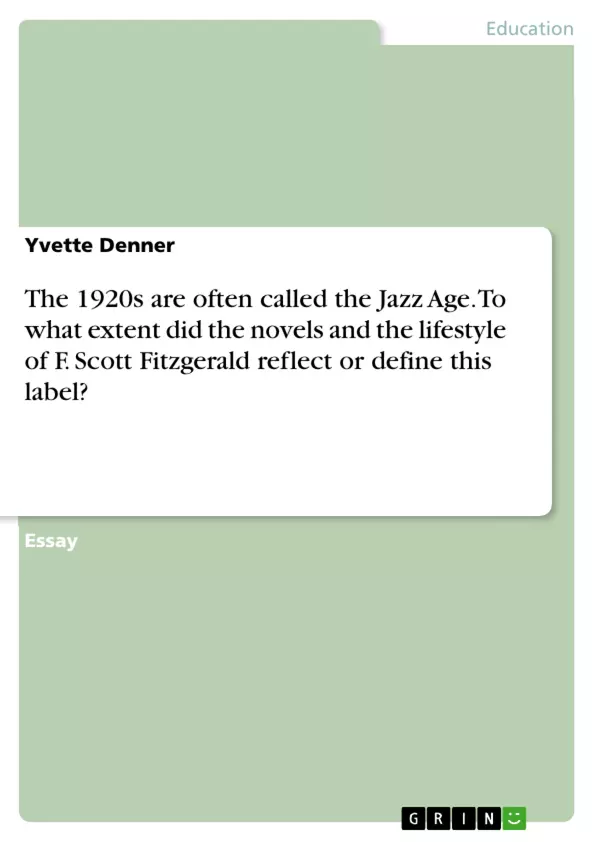In her book on American culture in the 1920s, Lynn Dumenil mentions that a key image of the period was leading “a fast life, propelled by riches and rapidly changing social values” (Dumenil 1995: 7). This is not entirely true. In fact, the 1920s, also known as the “Jazz Age” were a decade of contradiction: there was progress and prosperity on the one hand and depression and isolation on the other. The women’s suffrage and the Prohibition Act both passed in 1919 are somehow a characteristic introduction to the following ten years of contradiction in American history. One of the decade’s best known writers, F. Scott Fitzgerald, born on 24 September 1896 in St. Paul, Minnesota, celebrated his breakthrough after the release of his first novel This Side of Paradise in 1920 (Bruccoli 1981:13). His success literally came overnight and from then on his life changed completely (Allen 1931:90). Even though he was part of the fun generation which was so typical of the 1920s, he also embodied the characteristics of a moralist (Boyer 2009: 546). Fitzgerald’s life had been coined by ups and downs and by the end of the 1920s he caused his own downfall. Considering historical as well as biographical background information, this essay will provide an answer to the following question: To what extent did the novels and the lifestyle of F. Scott Fitzgerald reflect or define the Jazz Age?
Table of Contents
- Introduction
- The Jazz Age and its Contradictions
- F. Scott Fitzgerald and the Jazz Age
- Fitzgerald's Life and the Jazz Age
- The Impact of the Jazz Age on Fitzgerald's Work
- Conclusion
Objectives and Key Themes
This essay examines the relationship between F. Scott Fitzgerald's life and work and the cultural and social landscape of the "Jazz Age," the 1920s. It aims to determine the extent to which Fitzgerald's novels and lifestyle reflect or define this era.
- Contradictions of the Jazz Age: Prosperity alongside depression, social progress alongside societal divisions
- Fitzgerald's portrayal of the Jazz Age: Focus on flappers, hedonistic lifestyles, and the pursuit of pleasure
- Fitzgerald's personal experiences: The impact of success, alcoholism, and the rise and fall of his own personal "Jazz Age"
- Fitzgerald's literary contributions: His impact on the Lost Generation, his portrayal of the disillusionment of the post-war era
- The thematic resonance of Fitzgerald's work: The exploration of themes such as love, loss, and the pursuit of the American Dream in the context of the Jazz Age
Chapter Summaries
The introduction establishes the topic of the essay, exploring the definition and nuances of the "Jazz Age" and its connection to Fitzgerald's life and work. It poses the central question: to what extent did Fitzgerald's novels and lifestyle reflect or define this period?
The following chapter delves into the contradictions of the Jazz Age, highlighting its multifaceted nature. It discusses both the economic prosperity and social progress of the era, along with the prevalent poverty, societal divisions, and the rise of negativity and isolation.
The chapter "F. Scott Fitzgerald and the Jazz Age" explores Fitzgerald's early life and the impact of his breakthrough novel, "This Side of Paradise," on his career and the public perception of him. It analyzes how he became associated with the "Jazz Age" and his portrayal of the era's culture and social values in his writing.
The chapter "Fitzgerald's Life and the Jazz Age" examines the parallels between Fitzgerald's personal life and the cultural trends of the 1920s. It delves into his marriage to Zelda Sayre, their shared aspirations, and the eventual challenges they faced, drawing parallels to the contradictions of the Jazz Age itself.
The final chapter before the conclusion explores the influence of the Jazz Age on Fitzgerald's work. It discusses his representation of the Lost Generation, his exploration of the disillusionment and cynicism stemming from the aftermath of World War I, and his thematic portrayal of the hedonism and escapism prevalent in the 1920s.
Keywords
The primary focus of this text is on F. Scott Fitzgerald and his relationship to the cultural and social landscape of the "Jazz Age." The key themes revolve around the contradictions of the 1920s, Fitzgerald's portrayal of the era in his novels, his personal experiences, and the impact of the "Jazz Age" on his life and literary output. This includes key concepts like the Lost Generation, the pursuit of pleasure, the American Dream, and the social and economic anxieties of the post-war era.
- Quote paper
- Yvette Denner (Author), 2009, The 1920s are often called the Jazz Age. To what extent did the novels and the lifestyle of F. Scott Fitzgerald reflect or define this label?, Munich, GRIN Verlag, https://www.grin.com/document/151154



